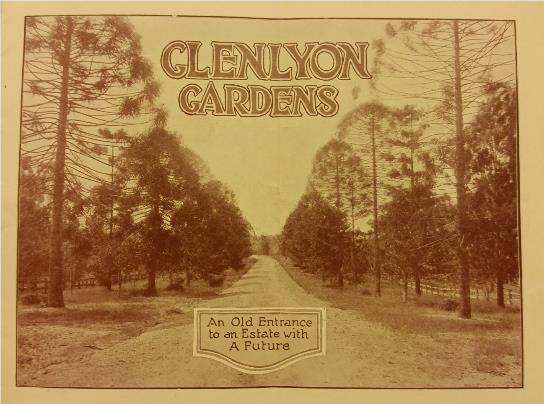Addresses
Addresses
This avenue of trees form the original drive leading from Waterworks Road to Glen Lyon villa, which was constructed in 1876-1877 for Alexander Stewart.
The drive was retained by T. M. Burke Pty Ltd when subdividing the original estate, and became Glenlyon Drive. The drive was marketed in their sales material as “An old entrance to an Estate with a Future”.
These trees are large, mature plants which dominate views along the street, providing an attractive entrance to Glenlyon Drive between Waterworks Road and Cypress Drive.
Key dates
Local Heritage Place Since —
Date of Citation —
Criterion for listing
(A) Historical; (B) Rarity; (E) AestheticInteractive mapping
Key dates
Local Heritage Place Since —
Date of Citation —
Criterion for listing
(A) Historical; (B) Rarity; (E) AestheticInteractive mapping
History
Glenlyon Drive was originally the drive leading up to Glen Lyon homestead, for which the estate and street are named. The bunya and fig trees appear to be those originally planted for owner Alexander Stewart to line the drive. Stewart was a partner in the merchant firm Stewart and Hemmant. Glen Lyon is the second oldest in the Ashgrove area after the so- 'Granite House' in St Johns Wood and was erected in 1876-7 as the centrepiece of Stewarts 250 acres estate. The property, which extended along both sides of Enoggera Creek, was named Glen Lyon after Stewart's birthplace in Scotland (Glen Lyon). Probably designed by architect James Cowlishaw, the original plans were modified when financial considerations forced Stewart to have a more modest residence erected.1
The drive was retained by T. M. Burke Ltd when he was subdividing the land as a statement landmark for the Glenlyon Gardens Estate. T. M. Burke Pty Ltd applied to the Council to make the area ‘first-class’ in 1926, and the Council adopted the recommendation under Clause 183 (Part 7) of the Local Authorities Acts Amendment Act that Lots 1 to 31 would be deemed ‘first-class’ and any houses built on these sites had to be constructed from stone, brick or concrete. This was due to the close proximity of the estate to trams, a planned shopping precinct and the relatively large size of the allotments – a real estate sign from 1923 advertises the estate as “the most beautiful home sites in Brisbane. No small allotments.” An A5 marketing booklet was produced by the company soon after the subdivisions were done, selling the exclusiveness of the estate by listing prominent residents already living on the site, listing the infrastructure available including parks and the close proximity to the (thenplanned) tram-line, and making statements like “No unsightly shacks will disfigure Glenlyon. Ample covenants protect buyers.” He also stipulates in the advertisements that the Lots are available at reasonable terms. The trees were featured on the second page of the sales brochure created by T. M. Burke Pty Ltd for the Glenlyon Estate and their heritage referred to in the catch-line “An old entrance to an estate with a future”.
A newspaper article in the Brisbane Telegraph dated 8 October 1948 describe them as “add[ing] to its [Glenlyon Drive] beauty and impressiveness. Ashgrove was promoted as an example of Brisbane’s future with modern residences and sales tailored to attracted young professional families.
There are approx. 30 trees which make up the avenue between Waterworks Road and Cypress Drive, and are planted alternatively with two species, both endemic to southeast Queensland:
- Hill’s Weeping Fig, Ficus microcarpa var. hillii – named after Walter Hill, first curator of the Brisbane Botanic Gardens
- Bunya Pine, Araucaria bidwillii
The street is striking in appearance and represents the core ideology of the estate – a first class area dominated by gardens and green space.
Description
There are approx. 30 trees which make up the avenue along Glenlyon Drive, between Waterworks Road and Cypress Drive. The trees are planted alternatively with two species, both endemic to southeast Queensland:
- Hill’s Weeping Fig, Ficus microcarpa var. hillii – named after Walter Hill, first curator of the Brisbane Botanic Gardens
- Bunya Pine, Araucaria bidwillii
Statement of significance
Relevant assessment criteria
This is a place of local heritage significance and meets one or more of the local heritage criteria under the Heritage planning scheme policy of the Brisbane City Plan 2014. It is significant because:
References
-
Glen Lyon, Queensland Heritage Register entry, Queensland Government, https://apps.des.qld.gov.au/heritage-register/detail/?id=600049
-
“Beauty in Trees”, Brisbane Telegraph, 8 October 1948.
-
Google Street View, Photo taken of Glenlyon Drive in December 2013, https://www.google.com.au/maps/place/Glenlyon+Dr,+Ashgrove+QLD+4060 (last accessed 19 February 2018).
-
JOL, SLQ, Glenlyon Gardens: an old entrance to an estate with a future, Brisbane: T.M. Burke Ltd, 192?., Record No. RBJ 728 GLE.
-
JOL, SLQ, Glenlyon Gardens, Ashgrove T.M. Burke, Land Agent ; Farley & Hanly, Surveyors. Brisbane, Qld.: T. M. Burke Pty., 192-?, Record No. 21124250270002061
Citation prepared by — Brisbane City Council (page revised April 2021)

